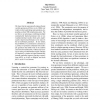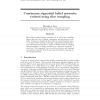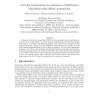1365 search results - page 34 / 273 » Learning with Product Units |
123
click to vote
PAMI
2002
15 years 3 days ago
2002
The product of experts learning procedure [1] can discover a set of stochastic binary features that constitute a nonlinear generative model of handwritten images of digits. The qua...
NAACL
2010
14 years 10 months ago
2010
We show that the automatically induced latent variable grammars of Petrov et al. (2006) vary widely in their underlying representations, depending on their EM initialization point...
NIPS
1996
15 years 1 months ago
1996
Real-valued random hidden variables can be useful for modelling latent structure that explains correlations among observed variables. I propose a simple unit that adds zero-mean G...
105
click to vote
CIIA
2009
15 years 1 months ago
2009
Petroleum industry production systems are highly automatized. In this industry, all functions (e.g., planning, scheduling and maintenance) are automated and in order to remain comp...
135
click to vote
EC
2010
14 years 9 months ago
2010
Estimation of distribution algorithms (EDAs) that use marginal product model factorizations have been widely applied to a broad range of, mainly binary, optimization problems. In ...



